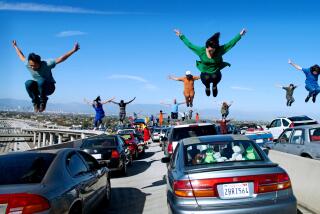Q&A: Cecil Balmond on his sculpture for Santa Monica Boulevard and why it honors a Persian emperor
- Share via
British artist, architect and engineer Cecil Balmond is creating a large-scale sculpture honoring Cyrus the Great, the emperor who ruled Persia 2,600 years ago.
Farhang Foundation, a Los Angeles nonprofit promoting Iranian art and culture, commissioned the work, “Freedom: A Shared Dream,” which will be installed next year on Santa Monica Boulevard in Century City.
The foundation held an international competition for the commission, vetting more than 300 submissions. Balmond’s public installations include Britain’s tallest public artwork, “ArcelorMittal Orbit,” a 376-foot-tall observation tower built for the 2012 Olympics. He was chosen for the Farhang project, though, largely because the jurors felt his design — a gigantic, modern-day interpretation of the Cyrus Cylinder — best embodied the values of diversity and personal freedom for which Cyrus the Great stood.
Jurors for the competition included the Museum of Contemporary Art’s Bennett Simpson, Tehran Museum of Contemporary Art’s Kamran Diba and the Los Angeles County Museum of Art’s Linda Komaroff.
“The Cyrus Cylinder is talismanic of a great vision for all peoples,” Balmond said. “I hope my design is an artwork which projects the cylinder’s deep values, not only to L.A. but also to the world.”
Can you tell us more about your vision for the sculpture?
The sculpture is made of two cylinders, one within the other. The interior cylinder is gold colored, and the outer cylinder is silver. In the daytime, the silver will sparkle, and at night, the gold will be illuminated.
The shapes are not solid but made from moving lines, like a kind of script. These appear to travel as you drive past and have an innate motion. They also evoke the writing on the original Cyrus cylinder at the British Museum. The form is held up by two circular rings, all crafted in stainless steel.
What’s your process in concepting a work of this scope?
My process is to imagine I’m a passerby looking at the sculpture, and then I sketch what I see. I elaborate on the sketches extending the idea, testing contrary ones, before coming back to the original instinctive idea — in this case, for L.A., a set of traveling lines. Then I go to the computer, draw and visualize, and then refine.
How do the values of Cyrus the Great show up in the work?
The values of Cyrus the Great is a message for all time, for all people. The declaration of human rights is a precious jewel for humanity, and I conceived the sculpture as such, a golden treasure [the inner cylinder] buried within the surface silver, the appearance of our lives.
Did the aesthetic of L.A. factor into the design at all?
The work was conceived for that specific site in L.A., the strong sunlight bouncing against the silver and at night, the gold lighting up as the great secret of Cyrus.
Your piece will be exhibited in a high-profile public spot. What do you hope it sparks in passersby?
I would like passersby to be excited by the sculpture and to feel it has not a superficial value but a timeless feel to it.
Now that you’ve won the competition, how close will you have to stick to the design you submitted — or is there room to improvise?
The realization will follow very closely to the original idea. I am very happy with the form and don’t consider any need for variation.
What else are you working on right now?
In addition to this work, I’m working on public sculptures for Iowa City, Chicago, Arizona, Toronto and Syracuse, N.Y. I’m also involved in city design projects around the world plus am furthering my research into the overlapping areas of art and science.
Follow me on Twitter: @debvankin
More to Read
The biggest entertainment stories
Get our big stories about Hollywood, film, television, music, arts, culture and more right in your inbox as soon as they publish.
You may occasionally receive promotional content from the Los Angeles Times.











